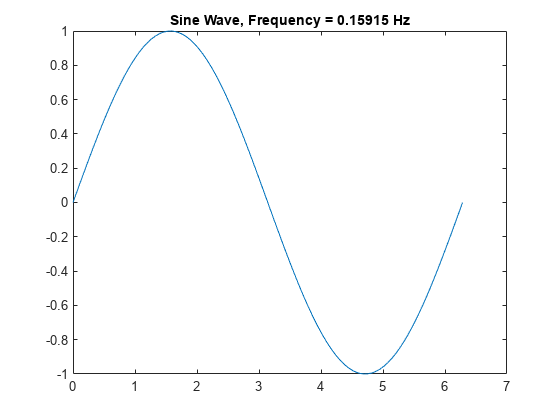Convert Numeric Values to Text
This example shows how to convert numeric values to text and append them to larger pieces of text. For example, you might want to add a label or title to a plot, where the label includes a number that describes a characteristic of the plot.
Convert to Strings
To convert a number to a string that represents it, use the string function.
str = string(pi)
str = "3.1416"
The string function converts a numeric array to a string array having the same size.
A = [256 pi 8.9e-3]; str = string(A)
str = 1x3 string
"256" "3.141593" "0.0089"
You can specify the format of the output text using the compose function, which accepts format specifiers for precision, field width, and exponential notation.
str = compose("%9.7f",pi)str = "3.1415927"
If the input is a numeric array, then compose returns a string array. Return a string array that represents numbers using exponential notation.
A = [256 pi 8.9e-3];
str = compose("%5.2e",A)str = 1x3 string
"2.56e+02" "3.14e+00" "8.90e-03"
Add Numbers to Strings
The simplest way to combine text and numbers is to use the plus operator (+). This operator automatically converts numeric values to strings when the other operands are strings.
For example, plot a sine wave. Calculate the frequency of the wave and add a string representing that value in the title of the plot.
X = linspace(0,2*pi); Y = sin(X); plot(X,Y) freq = 1/(2*pi); str = "Sine Wave, Frequency = " + freq + " Hz"
str = "Sine Wave, Frequency = 0.15915 Hz"
title(str)

Sometimes existing text is stored in character vectors or cell arrays of character vectors. However, the plus operator also automatically converts those types of data to strings when another operand is a string. To combine numeric values with those types of data, first convert the numeric values to strings, and then use plus to combine the text.
str = 'Sine Wave, Frequency = ' + string(freq) + {' Hz'}
str = "Sine Wave, Frequency = 0.15915 Hz"
Character Codes
If your data contains integers that represent Unicode® values, use the char function to convert the values to the corresponding characters. The output is a character vector or array.
u = [77 65 84 76 65 66]; c = char(u)
c = 'MATLAB'
Converting Unicode values also allows you to include special characters in text. For instance, the Unicode value for the degree symbol is 176. To add char(176) to a string, use plus.
deg = char(176); temp = 21; str = "Temperature: " + temp + deg + "C"
str = "Temperature: 21°C"
Hexadecimal and Binary Values
You can represent hexadecimal and binary values in your code either using text or using literals. The recommended way to represent them is to write them as literals. You can write hexadecimal and binary literals using the 0x and 0b prefixes respectively. However, it can sometimes be useful to represent such values as text, using the dec2hex or dec2bin functions.
For example, set a bit in a binary value. If you specify the binary value using a literal, then it is stored as an integer. After setting one of the bits, display the new binary value as text using the dec2bin function.
register = 0b10010110
register = uint8
150
register = bitset(register,5,0)
register = uint8
134
binStr = dec2bin(register)
binStr = '10000110'
See Also
dec2bin | dec2hex | char | string | compose | plus
